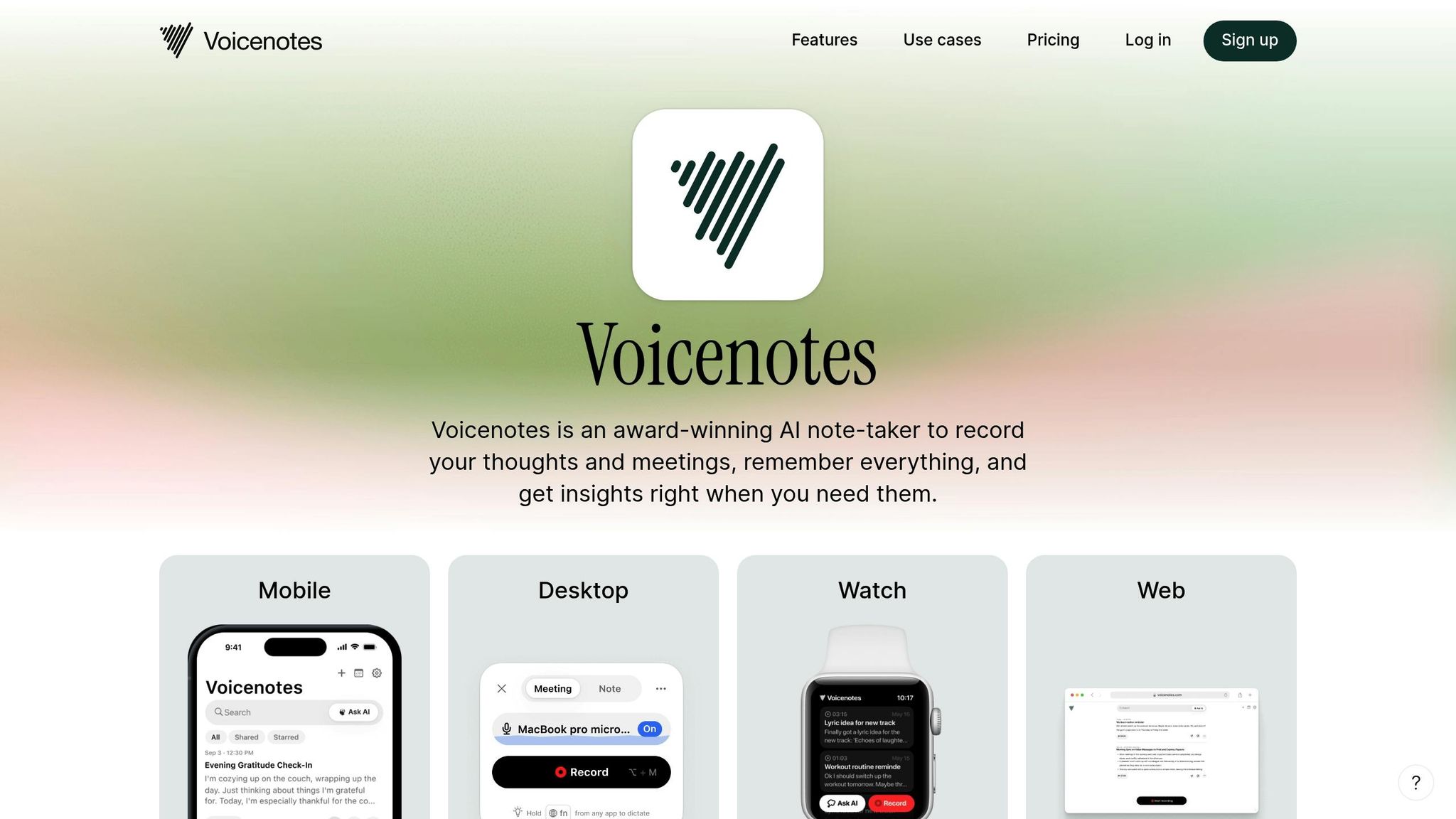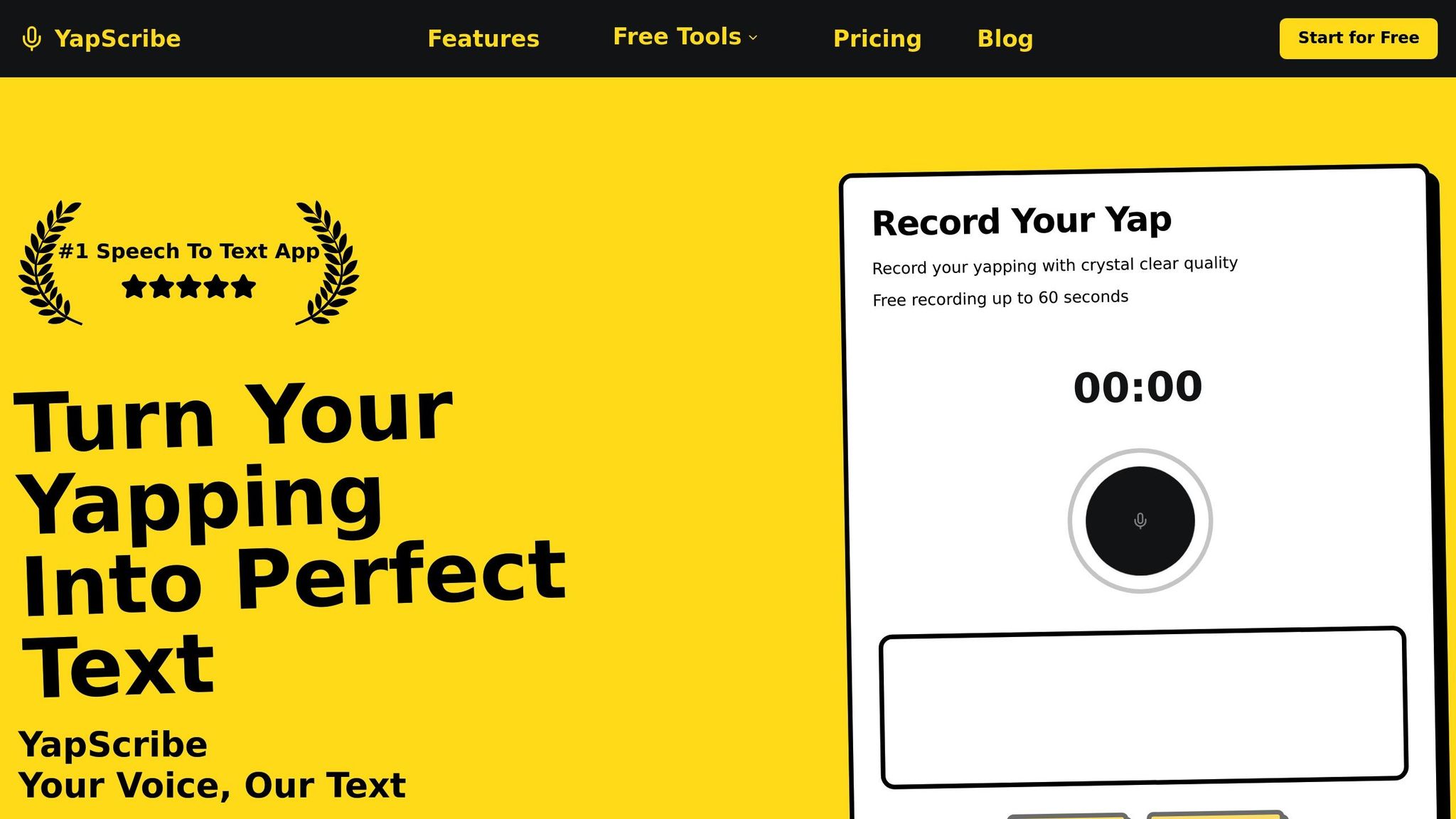Why Gen Z Loves Voice-to-Text for Productivity

Why Gen Z Loves Voice-to-Text for Productivity
Voice-to-text tools have become a go-to solution for Gen Z, helping them stay efficient and manage tasks effortlessly. Here's why:
- Fast and Efficient: Speech is up to four times faster than typing, allowing Gen Z to keep up with their fast-paced thinking and multitasking lifestyle.
- Ease of Use: These tools simplify email management, reduce typing strain, and make it easier to communicate while on the move.
- Flexible Communication: Voice notes and transcription tools enable quick updates and allow users to respond on their own time, reducing the pressure of live conversations.
- Tech-Savvy Fit: With most Gen Z owning smartphones and relying on digital tools daily, voice-to-text aligns perfectly with their habits and expectations.
Gen Z’s preference for these tools highlights a shift in how they approach work and communication - prioritizing speed, convenience, and better task management. Businesses and apps like YapScribe are adapting to meet these needs with features like real-time transcription, slang recognition, and secure sharing options.
Gen Z's Communication Preferences
Communication Challenges for Gen Z
Gen Z brings a fresh perspective to the workplace, but they also face some unique hurdles when it comes to communication. A striking 36% of managers and leaders note that Gen Z employees often struggle with workplace communication, revealing a gap between their natural communication style and traditional expectations.
One of the biggest challenges? Live conversations. A staggering 90% of Gen Z reports feeling anxious about phone calls, largely because of the fear of saying the wrong thing in real time. This anxiety doesn’t just stop at personal interactions - it spills over into professional settings, where traditional methods of communication, like phone calls, can feel daunting.
"It turns out talking on a phone call is a skill and, for decades, we didn't recognize that, because we all did it."
- Mary Jane Copps, Communication consultant/coach
Email management is another pain point. While only 18% of the general workforce has over 1,000 unread emails, that figure jumps to 36% for Gen Z professionals. They often find it challenging to switch from casual text messages like "Got it thx!" to the more formal tone required in professional emails. This shift can feel like a significant adjustment and sometimes slows productivity.
"The upcoming generation has been told, 'Be yourself! You're you, and you're wonderful!' But there's a tension when they start working in a more corporate environment."
- Michelle Ehrenreich, Director of the communications program at Boston University's Questrom School of Business
Additionally, written communication lacks vocal tone and immediate feedback, making it harder for Gen Z to pick up on subtle nuances. This can lead to misunderstandings and further complicate workplace interactions.
Given these challenges, it's no surprise that Gen Z gravitates toward communication tools that are more immediate and flexible.
Real-Time Tools in Gen Z's Workflow
To navigate these challenges, Gen Z has embraced digital tools that prioritize speed and flexibility. They prefer platforms that offer quick, clear updates and align with their fast-paced, multitasking lifestyles. Voice-to-text tools, for example, are particularly appealing because they allow users to communicate while juggling other tasks - a convenience that traditional phone calls, which demand undivided attention, often lack.
In fact, over 70% of Gen Z and Millennials opt for digital channels for their communication needs. These tools not only provide the immediacy they value but also give them control over how and when they communicate. Dr. Carol Soon, Principal Research Fellow at the Institute of Policy Studies, highlights this preference:
"Texting provides youths with more control over their schedules as they can communicate whenever they want, allowing them to multi-task and avoid small talk."
Gen Z also places a high value on authenticity and transparency in communication. Voice-to-text applications strike a balance by capturing the tone and emotion of spoken words while offering the ease of a written format. These tools enable quick responses and real-time exchanges, perfectly aligning with Gen Z's need for instant communication and genuine interaction.
A modern note-taking app that gets to the point | Voicenotes

How Voice-to-Text Improves Gen Z's Productivity
Voice-to-text tools are becoming a game-changer for Gen Z, helping them tackle communication challenges and boost efficiency like never before. By addressing traditional barriers, these tools enable faster, smarter ways to work.
Faster Task Completion with Voice-to-Text
One of the biggest advantages of voice-to-text is speed. It can triple the pace of writing by capturing thoughts as they flow, perfectly complementing Gen Z's fast-paced thinking. Typing often struggles to keep up with their rapid ideas, leading to lost thoughts or unfinished tasks. Voice-to-text eliminates this gap, ensuring that ideas are captured in real-time.
Take email management, for example. Dictating emails feels natural and quick, making it easier to stay on top of communication. Voice notes are also gaining traction. In fact, 62% of Americans have sent a voice message, with 43% of people aged 18 to 29 using them at least weekly. This growing trend shows how voice-to-text aligns with Gen Z's communication style while simultaneously improving productivity.
Better Task Management and Collaboration
Voice-to-text isn't just about speed; it’s also a powerful tool for multitasking. Gen Z spends roughly 26% of their day multitasking on connected devices. Voice input allows them to capture ideas while walking, driving, or even working out, reducing the need to pause and type. Plus, it eases the physical strain that often comes with long typing sessions.
Voice notes, in particular, offer a unique edge. They capture tone and even background context, making them ideal for quick updates or brainstorming without the need for a full-blown conversation. This resonates with Gen Z's preference for casual and authentic communication. Unlike phone calls, voice notes are low-pressure, letting team members share ideas or updates at their own pace.
The global popularity of voice messaging further underscores its impact. For instance, WhatsApp users send a staggering 7 billion voice messages every day.
sbb-itb-0fa31c1
YapScribe's Benefits for Gen Z Users

YapScribe stands out as a voice-to-text tool tailored to meet the fast-paced, tech-savvy lifestyle of Gen Z. With over 55% of Gen Z employees believing technology enhances their productivity, YapScribe provides the tools to simplify workflows and improve efficiency. Its features are designed with this generation's unique needs in mind.
Features That Speak Gen Z's Language
YapScribe's AI transcription technology is built to capture Gen Z's slang and conversational tone, delivering highly accurate text in real time. This instant transcription ensures users can keep up with their demand for speed and efficiency.
The platform goes beyond simple transcription by identifying key points and actionable tasks as users speak, making it easier to stay organized. With secure storage, YapScribe addresses Gen Z's growing concerns about privacy, safeguarding their personal data. Additionally, the platform's seamless sharing capabilities make it easy to distribute transcripts, fostering collaboration in hybrid and remote work setups.
Budget-Friendly Plans for All Users
YapScribe pairs its powerful features with pricing options that cater to different user needs. Here’s how the plans break down:
| Plan | Price | Features | Ideal For |
|---|---|---|---|
| Lifetime Deal | $24.24 (one-time) | 10 hours/month, future updates, priority support, 30-day guarantee | Regular users looking for long-term savings |
| Regular Plan | $2.24 per hour | Full feature access, secure sharing, real-time transcription, regular updates | Casual users or those testing the service |
The lifetime deal, priced at $24.24, offers excellent value for frequent users, providing 10 transcription hours each month along with priority support and future updates. For those who prefer flexibility, the pay-as-you-go option at $2.24 per hour delivers full access to all features without requiring a subscription, making it perfect for occasional use.
Regardless of the plan, every user benefits from YapScribe's advanced transcription technology, secure data storage, and easy sharing options, ensuring a smooth and reliable experience.
Conclusion: Voice-to-Text Changes Gen Z Productivity
Voice-to-text technology is reshaping how Gen Z approaches work and productivity. With 78% of young workers using AI tools daily, this generation isn't just embracing voice-enabled solutions - they're redefining workplace communication.
Small businesses are already reaping the rewards. Voice-enabled tools have led to an average 34% reduction in administrative overhead within just three months of implementation.
The impact goes beyond efficiency:
"Gen Z is changing work by using AI tools every day for content creation and data analysis. They don't see AI as a separate tool but as a work partner." – Shacara, Author at My CV Creator
This shift aligns seamlessly with Gen Z's natural tendencies. Since speech is up to four times faster than typing, and 36% of workers feel voice is a better way to interact with AI compared to 15% who prefer typing, voice-to-text tools enable a more fluid exchange of ideas - something often lost when typing.
Additionally, 65% of young workers believe AI makes work more creative and enjoyable. For example, one business owner reported a 40% increase in actionable ideas after adopting voice input, showing how these tools can unlock new levels of potential.
The trend is only gaining momentum. Gartner predicts that by 2026, 85% of small businesses will integrate voice interfaces into their core operations. For Gen Z, this represents more than a technological shift - it signals a workplace designed around natural communication rather than rigid software constraints.
Gen Z’s comfort with AI-powered voice tools is setting a new benchmark for productivity and collaboration. Their preference for spoken communication is driving these changes, and companies that invest in AI infrastructure to support this shift will be better equipped to attract and retain this tech-savvy generation. The future of work isn't just about speed - it’s about creating processes that feel intuitive and amplify human creativity.
FAQs
How does using voice-to-text help Gen Z work more efficiently than typing?
Voice-to-text tools are transforming how Gen Z approaches work by speeding up tasks compared to traditional typing. Since speaking is often faster than typing, these tools save time and reduce the effort needed for repetitive or less important tasks.
Another big advantage is mobility. With voice-to-text, users can work from almost anywhere, giving them the freedom to adapt to different environments. This flexibility not only aligns with Gen Z's fast-paced, tech-driven lifestyle but also sparks creativity. By streamlining task management and enhancing productivity, voice-to-text has quickly become a favorite tool for this generation.
What workplace communication challenges does Gen Z face, and how can voice-to-text tools help?
Gen Z frequently faces hurdles in workplace communication, such as feeling anxious about phone calls and favoring text or visual methods. These preferences can sometimes result in misunderstandings or struggles to convey ideas clearly.
Voice-to-text tools offer a helpful solution by providing a straightforward and low-pressure way to communicate. They enable individuals to express their thoughts without the stress of real-time conversations, aligning with Gen Z's inclination for asynchronous communication. Additionally, these tools boost productivity by minimizing miscommunication and ensuring ideas are recorded accurately and efficiently.
Why does Gen Z prefer using voice notes instead of phone calls in professional settings?
Gen Z prefers voice notes over live phone calls in professional settings because they feel less stressful and more convenient. Unlike phone calls, which can sometimes feel intrusive or trigger anxiety, voice notes offer a way to communicate thoughtfully without the immediate pressure of a live interaction.
Another advantage of voice notes is their flexibility. They allow for asynchronous conversations, making it easier to fit communication into packed schedules. This matches Gen Z's preference for quick, casual, and efficient ways to stay connected and productive at work.